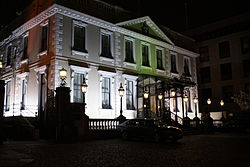- Mansion House, Dublin
-
Mansion House Teach an Ard-Mhéara
The Mansion House, 2011.General information Type Official residence of the Lord Mayor of Dublin Location Dawson Street, Dublin Design and construction Owner Dublin Corporation The Mansion House (Irish: Teach an Ard-Mhéara, meaning "House of the High Mayor") on Dawson Street, Dublin, is the official residence of the Lord Mayor of Dublin since 1715.
Contents
Features
The Mansion House's most famous features include the "Round Room", where the First Dáil assembled on 21 January 1919 to proclaim the Irish Declaration of Independence. On 21 January 1969 a special fiftieth anniversary joint session of Dáil Éireann and Seanad Éireann assembled there and was addressed by the then President of Ireland, Éamon de Valera.
Also notable is the large dining room, where the cabinet of the Irish Republic met on occasion under President Éamon de Valera.
Externally, the distinctive metal portico over the main door was erected for the visit of Queen Victoria in 1900.
Visitors and occupants
Its most famous occupants included Lord Mayors:
- Daniel O'Connell, nineteenth century nationalist leader
- Alfie Byrne (1930s), longest serving Lord Mayor in the 800 year history of the office
- Jim Mitchell (1976–77), the youngest Lord Mayor of Dublin, aged 29, in the history of the office
Famous visitors to the mayoral residence include:
- Prince Rainier III and Princess Grace of Monaco
- Pope John Paul II
- Queen Victoria
History
The Mansion House was built in 1710 by the merchant and property developer Joshua Dawson, for whom Dawson Street is named. Dublin Corporation purchased the house in 1715 for assignment as the official residence of the Lord Mayor. It retains this purpose to this day.
In the 1930s and 1940s, plans were made to demolish the building, and all other buildings on the block on which it is located (which covered an area on Dawson Street, Molesworth Street, Kildare Street and the North side of St. Stephen's Green), to enable the building of a new Dublin City Hall. However the decision of the Government to erect a new Department of Industry and Commerce on a site on the block, on Kildare Street, led to the abandonment of the plans.
In August 2006, the loyalist paramilitary Ulster Volunteer Force claimed they had planted a bomb in the Mansion House in 1981, in an attempt to wipe out the Sinn Féin leadership at their party conference of that year.[1] The claim led to a security alert at the house, as the Garda and army searched for the 25-year-old bomb.[2]
References
- ^ UVF Sinn Féin massacre plot — The Belfast Telegraph newspaper article, 31 August 2006.
- ^ Search under way at Mansion House — RTÉ News, 31 August 2006.
External links
Coordinates: 53°20′25″N 6°15′29″W / 53.340278°N 6.258178°W
Irish parliament houses (1600s–present) 1600s–1800 Chichester House (1600s–early 1700s) · Blue Coat School (early 1700s–1729) · Parliament House (1729–1800)
1919–present Mansion House (1919), (1922) · UCD (Earlsfort Terrace) (1919–1922) · Royal College of Science (1921) · Leinster House (1922–present)Belfast City Hall (1921) · Union Theological College (1921–1932) · Stormont (1932–1972), (1999–present)Categories:- Buildings and structures in Dublin (city)
- Official residences in the Republic of Ireland
- Government buildings in Ireland
- Houses completed in 1710
Wikimedia Foundation. 2010.



